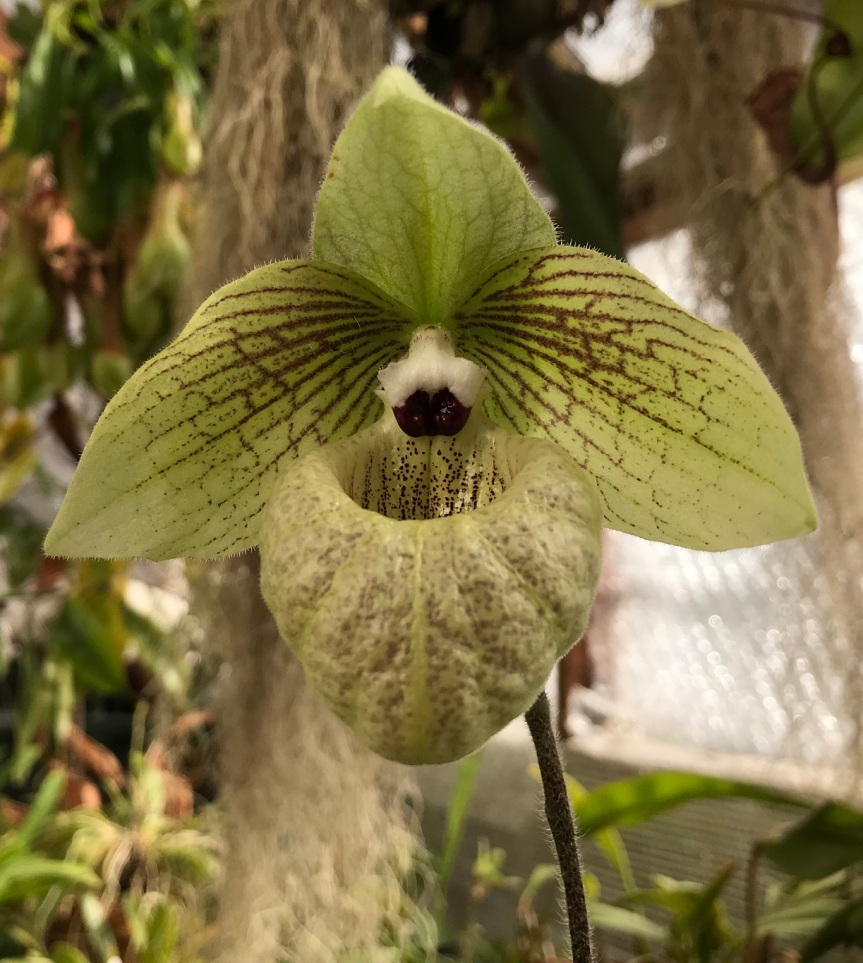
Paphiopedilum malipoense is a slipper orchid from southern China (Yunnan, Guangxi, Guizhou) and northern Vietnam that somehow managed to escape the notice of orchid collectors and botanists until the 1980s–the species was described in 1984. It isn’t the most exquisitely beautiful slipper orchid, but the green flowers with maroon spotting and tessellation have a certain bizarre charm. The dark spots on the inside of the inflated pouch show through the thin tissue, making the pouch appear mottled. Most Paphiopedilum flowers are scentless, but those of P. malipoense have a pleasant raspberry fragrance, a characteristic that seems to be passed on to its first-generation hybrids.

I haven’t been growing P. malipoense for very long, but I have had its primary hybrid, Paphiopedilum Lynleigh Koopowitz (P. malipoense x delenatii) for about fifteen years. P. Lynleigh Koopowitz grows and blooms well in my greenhouse, as does its other parent, P. delenatii, so I have some hope that P. malipoense will prove equally reliable.

P. Lynleigh Koopowitz combines the best characteristics of both parents. From P. malipoense, it inherits raspberry fragrance and fine markings on its petals, but P. delenatii genes convert the green/maroon color combination to white/purple. Some P. delenatii specimens are also fragrant, though to my nose they smell quite different from P. malipoense and P. Lynleigh Koopowitz.

The history of P. delenatii in cultivation is a fascinating story. A few plants were collected in Vietnam during the early 1900s, but the species was believed extinct in the wild soon after it was described in 1924. For the next seventy years, all of the known P. delenatii were descended from a single plant grown at a nursery in France. Not surprisingly, genetic diversity was almost nonexistent among the cultivated plants, and they all looked virtually identical. Then, in the 1990s, the species was rediscovered in southern Vietnam, and large numbers of plants were collected (mostly illegally). Cultivated P. delenatii now includes white (alba) and very dark (vinicolor) specimens. My plant, shown above, is typical of the old cultivated type.
P. delenatii is now listed as “Critically Endangered” on the IUCN Red List. One might hope that artificial propagation has reduced collection pressure on the wild population, but somehow I have my doubts.

I remember seeing a few pictures of these or something similar in an old fashioned slide show about vireyas in the same region. I did not pay much attention them, but I remember how the person who took the pictures described how local people in rural Vietnam grew them in pots around their homes as if they were nothing important. I don’t remember much about vireyas either just because we grow only rhododendrons that live in the local climates.
LikeLiked by 1 person
Beautiful flowers. I have some blue color local orchid variety in my greenhouse which has a very pleasant smell, it looks like the flower in the first photo, only the color is different.
LikeLike